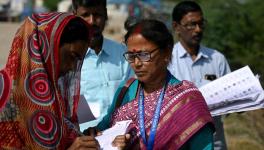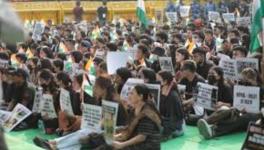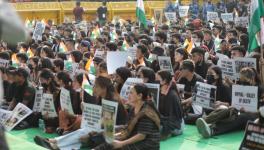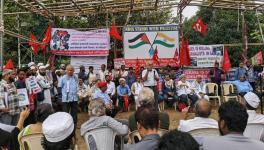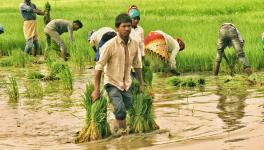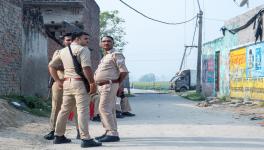From Manipur, A Peace Activist’s Account Of State Criminality & Culpability
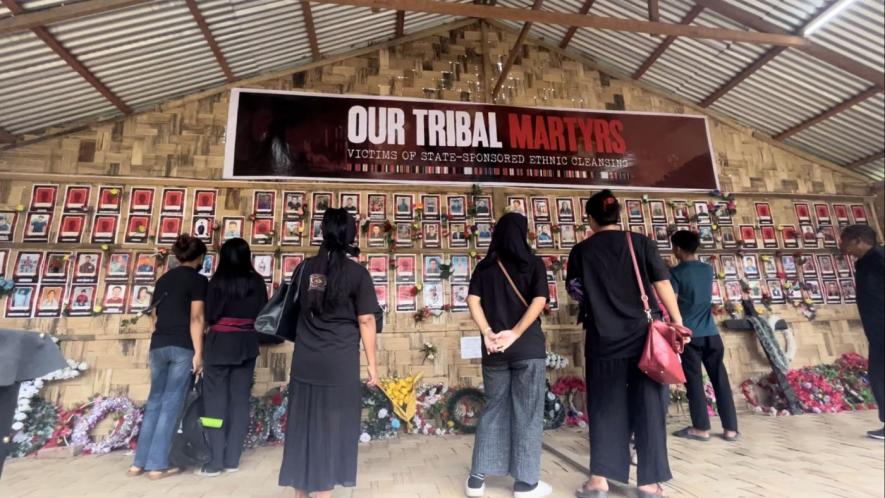
Visitors at the ‘Wall of Remembrance’ set up in the memory of people of the Kuki-Zo community who lost lives in the violence.
In this blow-by-blow account, peace activist Harsh Mander describes his journey to Manipur, where he met Meitei and Kuki families broken by three months of ethnic violence, life inside the camps where hundreds live in despair, unsure if they will ever return to their scorched villages, and the “extreme culpability” of a seemingly partisan state that has done little to help the minority Christians who have been killed and uprooted in greater numbers.
Delhi: In the four days that ten peace activists were in India’s northeastern state of Manipur, convulsed in ethnic and religious violence since May, nothing brought home the theatre of war like the gunfire and mortar explosions they passed while returning from the Kuki camps to the capital Imphal on 27 July.
Two days later, Harsh Mander, who led the team from Karwan e Mohabbat, a campaign for peace and solidarity he started in 2017, told Article 14: “It was very scary.”
“We could hear the sounds of gunshots close at hand and mortar bombs. It became really difficult to know what to do,” said Mander. “When we reached the border, the sound of firing was very close. It was within 100 metres.”
In the state of 3.2 million people, Meiteis are mostly Vaishnavite Hindus who make up more than half the population and live in the Imphal valley, while the Christian Kukis are far fewer and live in the hill districts.
Of the 182 people killed in the past three months, according to the government data reviewed by Reuters, 113 were Kukis and 62 were Meiteis, suggesting the minority ethnic group has borne the brunt of three months of violence in the state government run by the Bharatiya Janata Party (BJP) for the past six years.
Some believe that Biren Singh, the 62-year-old chief minister of the state and a Meitei, has played a partisan role in the ethnic conflict that has caused tragic loss of life, displacement, and deep anguish for those whose loved ones have been killed and their homes set on fire by the warring factions.
Old divisions are seen to have deepened under his leadership and his “war on drugs”, which has solidified and sharpened the narrative of Kukis being illegal immigrants from Myanmar engaged in poppy cultivation which leads to the production of brown sugar and other drugs that destroys the Meitei youth. They have also been vilified as people clearing protected forests and hurting the ecology.
The ethnic violence erupted after the Kukis protested the judgement of the Manipur High Court, telling the state government to consider including the Meitei community in the Scheduled Tribes’ list.
In all his years as an IAS officer and then as an activist, Mander said he had never seen anything like the recent events in Manipur, which he said was engaged in a civil war or on the cusp of devolving into one. The partisan role of the state government, the abdicating of responsibilities to help the minority, and the central government’s silence, was similar to the Gujarat riots in 2002, where Muslims were targeted and suffered disproportionately. But the weapons being used in Manipur were more modern and deadlier.
The failure of the state was threefold, said Mander.
The government had failed to prevent the violence, was unable to disarm and detain the people who had instigated or participated in the violence once it broke out, and failed to bring innocent civilians to safety and establish relief camps for them, with complete provisioning of food, sanitation, health care and education, with particular focus on children, women and older people.
For the longest time, until a leaked video of sexual assault on Kuki women went viral and available for the world to see, Prime Minister Narendra Modi said nothing about Manipur.
When Karwan e Mohabbat started amid a tide of Islamophobia, Mander said it was to help the families of Muslims who were being lynched in the Hindu majoritarian state.
Somewhat ironically, in the clash between Hindus and Christians in Manipur, Mander said Muslims were the safest identity to have in the state at the moment, a likely exception to the rest of the country. “There was a strange irony…,” he said.
In this interview, Mander spoke of what he and other peace activists, including veteran journalist John Dayal, three doctors and his younger colleagues from Karwan, witnessed in the camps, their own terrifying encounter on the day violence broke out, and why the culpability of this human tragedy rests with the governments.
“I think collectively, we have failed the people of Manipur in a very profound way,” said Mander. “The extreme culpability of the governments that we have elected seems to have completely abandoned any sense of their constitutional duties. Both the governments in Manipur and at the centre have failed us.”
Tell us what you saw in Manipur.
Manipur has been transformed into a war zone. It was like visiting Bosnia. There were bombs, mortar shells being blown, people with modern weaponry & the massive mobilisation of the civilian populations. We are already at the cusp of a civil war or have entered it. In the four days we were there, we spoke with people in seven relief camps from both communities and many community leaders on both sides. The preoccupation on both sides was the narratives where the other community were recreated as people of immense evil. The whole fight is portrayed as a battle for survival. I am unwilling to apportion blame to one community or another. I don’t think it is appropriate.
It is the state’s role where I would lay the central culpability for the massive upheaval, loss of life. I would stick my neck far out and say the criminal role of the state authorities for failing to prevent the violence and to control it in the shortest amount of time with all the force that it can muster. The state government has been unable to reassure the Kuki minorities that it has acted with fairness; instead, they widely believe that the state government is actively partisan in the ensuing battle against them. The Manipur chief minister’s partisanship is open for everyone to see. His statements feed into the intense stigmatisation of the other community. We can also talk about other chief ministers like the chief minister of Assam, Uttar Pradesh, who flaunt their hate partisanship in majoritarian politics. In these kinds of battles, where mutual recrimination and stigmatisation have blown up into major hate, the CM should mediate and ensure that hate constructions are countered—both are citizens of India and have rights.
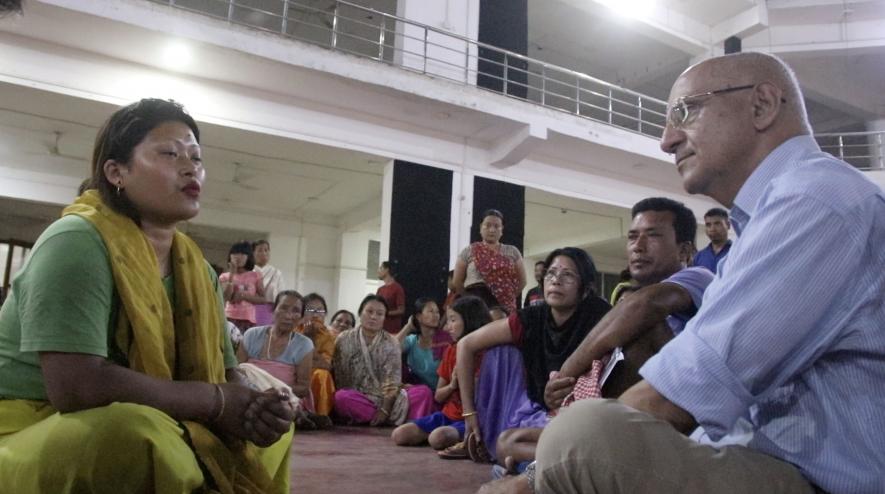
Harsh Mander, at Akhampat Relief Camp, Imphal East District, listening to a survivor from Meitei Community who escaped her home that was set on fire in the violence.
You speak of how what is happening in Manipur is similar and dissimilar to the Gujarat killings in 2002.
I’ve worked on this in different capacities, from the 1984 riots within and outside the IAS. I’ve worked in Gujarat (2002). I’ve never seen anything like this. What is unfolding, there is civil war. What is common with Gujarat is the enabling role of the state with the majority community, the manufacturing and sustaining of hate, and the state’s refusal to do anything to extend relief to the minority. It was left to the very battered Muslim community to take care of themselves.
There are an estimated 20,000 people from the Kuki community whose villages have been burnt to ashes, and they had to run away. We found not a single government relief camp. People are being accommodated on church campuses. The money is raised mainly by local people. We saw small children having rice water with salt. There were no educational facilities. The duty of the state is to prevent violence and extend relief, and secure justice—the state has done none of these. But in Gujarat, they were not fighting with AK-47s, dropping mortar. That’s a huge difference.
What did you do on your first day?
On the 25th, we visited some of the relief camps in Imphal. The stories we heard in the camps of the Meitei internally displaced people were often very similar to those of the Kuki people. In those mountainous areas, where Meiteis were in the minority, they suffered with their houses and villages razed to the ashes. They talked about the anguish of their neighbours, who have lived peacefully for generations, suddenly turning against them. And we would hear the hate narratives about why the Kuki people are so responsible. The Meitei camps were at least on government buildings and stadiums. There was some degree of state support. That was completely absent in the Kuki camps.
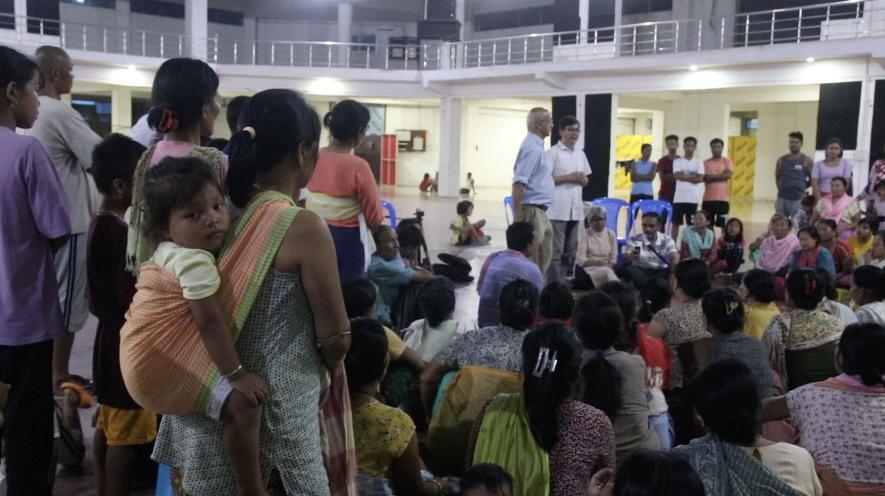
Residents of Akhampat Relief Camp, Imphal East District interacting with team Karwan e Mohabbat.
Who was running the camps where Meiteis were seeking refuge?
I tried to make this out, but it wasn’t very clear. These were also community-run but with much more conspicuous state support using state premises, and government buildings, with food supplies coming in. But having been an administrator myself—I know government camps should have government officials taking the lead in organising things. That I didn’t see here.
Were there a lot of small camps or a few large ones?
The Kuki camps were much smaller. They were more in number than the Meitei camps because the number of people affected was much higher among the Kuki people, and the camps were also smaller.
What did you do on the second day ?
There is now a place they call the border (of Churachandpur district), beyond which it was unsafe for Meitei people to travel. A respected human rights leader of Meitei origin, Babloo Loitongbam, accompanied us, but even he had to stop at one point when we faced the first barrier. They showed military bunkers here, and the Meitei people pointed out bunkers that had come up on the other side, which they claimed to be civilian bunkers of the Kukis. At this point, it started to look like a clear war zone. We were told that we had to be very careful that the taxi drivers must be of Muslim identity. There was a strange irony that, unlike any other part of the country, the safest identity to have was Muslim.
Were the bunkers of non-state actors?
It was too far for us to make out. But the narrative from this side is that the bunkers were of non-state actors. Another complication is that the Meitei people believe that the Indian Army, that is, the Assam Rifles, are in support of the Kuki people. And the Kuki people are convinced that the paramilitary forces in Manipur and the police are completely partisan in support of the Meitei people. It is a strange place where even uniformed forces cannot act across this divide that has been created. That is the level of mistrust. Different security forces have different barriers. One by one, they consider and let you go.
What did you see in Churachandpur?
We heard the Kuki people no longer wanted to use Churachandpur because it was named after a Meitei king. Its older name was Lamka. So I also used the name Lamka. A pastor, Reverend Lamboi Haokip, took us to a Kuki camp in a place called Khulum, and they spoke about having to escape where Kukis were in the minority. Suddenly, their homes were burnt down. People attacked with guns and weapons. There were mirror-image stories about escaping. They carried one woman, who was completely paralysed, over the mountains and hid her in a cowshed for several days.
One Kuki man was working with two other Kuki men at a petrol station in the Imphal area. A mob came and asked for the three Kuki men. One of them was bludgeoned to death. The second was also bludgeoned and left for dead. This man’s story was that he was taken to a hospital and just being sent to the mortuary when a doctor from the mainland took his pulse and felt a very mild beat, and rushed him to the ICU. In this way, he was brought back from the dead. He found his family in the camps. I asked him how he felt, and he said that he had initially resolved that he would kill the people who had tried to kill him, but now he had forgiven him. It was very touching to meet him.
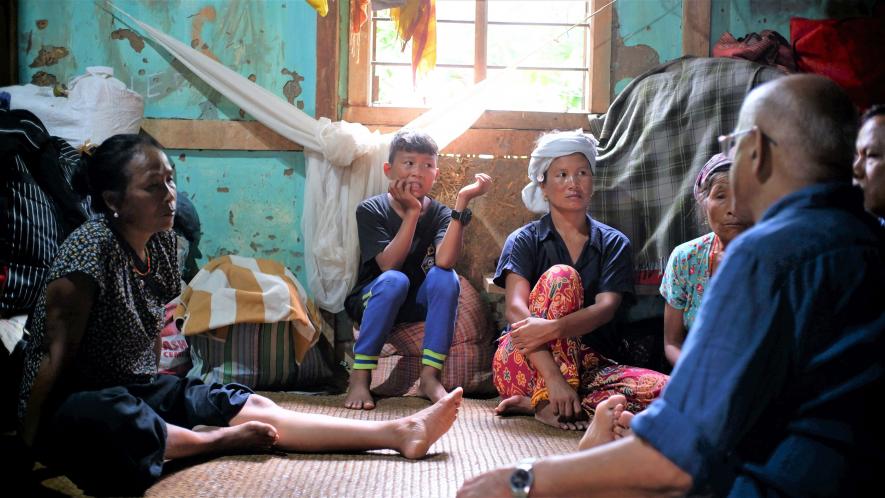
Family members of a paralyzed woman rescued during the violence sharing their ordeal at the Kholum Church Relief Camp, Churachandpur/Lamka
What was the next day like?
The Kuki people have put up a wall of remembrance with pictures of people killed. Students of Lamka have created a memorial with empty coffins. It is an extraordinary kind of mobilisation. A few thousand women gather every second day. They dress in black as a sign of mourning. They sit and remember and grieve. They are songs. We organised an impromptu interfaith prayer. We had a Muslim prayer, a Sikh prayer, a Christian prayer, and a Hindu prayer—we sang Raghupati Raghav. We remembered everyone who had been killed.
We convened a meeting of civil society organisations to hear about their views and the relief challenges. I realised by then that there was no resolution in sight and that it could be months or longer. People will continue living in these camps and will not be able to return. They just said they had no resources and did it entirely with their local resources. I also told them they must sit together and make a demand from the state. People without work for months and months could have a special NREGA connected with the regeneration policy. They should have PDS rations distributed free and so on, double the pensions, and temporary schools. I was helping them imagine and plan what they could demand from the state government for sustained relief.
Mander said that later that day, they heard news of a “major” shootout near the border they had crossed. We asked him to describe what it was like returning to Imphal Valley.
We wanted to visit a few more camps, but the driver said that if the sun set, then it would be impossible for them to go. The pastor said he was rushing because some people had been injured in the firing. There was generally a lot of mayhem, and we were more or less on our own. We left and started returning through the same barriers. We could hear the sound of gunshots close at hand and mortar bombs. It became really difficult to know what to do. There was an army picket, some paramilitary picket. They would keep pulling us back and then letting us go. They were also just 50 metres apart. When we reached the border, then the sound of firing was very close. It was within 100 metres. I asked my colleagues to bend down and not be visible from the window of the vehicles, and we drove quickly through.
100 metres. That must have been very scary.
It was very scary. I was scared because I was the group leader, and I wanted everyone to pass through safely.
You were hearing gunfire.
And mortar. It was happening around us.
This sounds dangerous.
It was very dangerous. I was surprised at the army unit’s refusal to offer protection. They said you are on your own.
What was the atmosphere like in the taxis you were in?
Everyone was very equanimous. Nobody panicked. I played a small game with them. What was the dominant thought in their heads and hearts when we were passing through it? I thought we must come through safely, and if anyone had to be shot, it should be me and not any of them. Latifur (a member of the group) said he found it thrilling. He talked about hearing all this, but now he was in the middle. This is what a war zone looks like.
You came out of it.
We came out on the other side, and what we saw was stunning. We encountered another barrier that Meitei civilians had set up. They were very angry and said, ‘They are shooting and burning our rooms here.’ But we explained why we had come, and they let us pass. The road was full of thousands of Meitei people who had gathered. They had come with great anger and rage. In some places, women did ritual gestures, like when soldiers were going out to war. It is not only a huge mobilisation of guns, rifles and weaponry, with two sets of militants fighting each other, but also a visible mass public uprising.
But what had happened?
We tried really hard to find out what happened. Rumours began to spread on both sides—10 people have died, 11 people have been killed—blaming each other for starting it. They have established bunkers along the hillside. Nobody would agree as to what exactly happened. Still, people started fighting and throwing bombs at each other across what has become the border in this war-like situation, which is just the border between the two districts.
From the time you left the Kuki camps to crossing the Churachandpur border, how long did it take?
It took about three hours. We left at around 2:00 pm and crossed the border at around 5:30. We were stopped from place to place.
How much of this time were you close to the gunfire, mortar?
At least an hour. It brought home what it means to be in a war zone. Whether 1984, Gujarat 2002 or Bhagalpur, this was something else.
What did you do on your fourth day?
What was particularly remarkable was the mothers of the Meira Paibi group. Their most iconic moment was when they protested rape by army men. The mothers stood in front of the army garrison and stripped naked, and they said rape us. There was adverse news alleging they supported the militants to the extent of encouraging the men to rape Kuki women. I wanted to hear from some senior members. They spent much of the morning on their views and feelings, reflecting the Meitei narrative that demonises the Kuki people. They reflected on why they felt this was such a crucial battle for the survival of the Meitei people.
Before we left for Manipur, we met Kuki people in Delhi who asked if we could visit where they lived, where homes and churches were burnt down. That was the last thing we did. We visited this entire settlement within Imphal town as they wanted us to. We took pictures. The Kuki people have still not buried bodies. They are still in the mortuary. There were at least 100 bodies in the mortuary in Lamka. And an uncounted number in Imphal. From a safety point of view, people couldn’t go and identify.
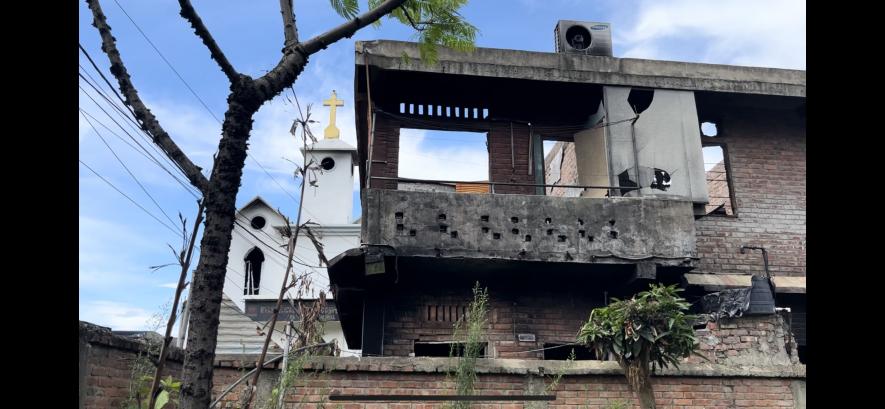
Post violence visuals from the Sangaiprou locality in Imphal.
Kukis are disproportionately affected. How do peace activists like yourself hear both sides?
It was clear in my mind and heart that we would listen to people for the humanitarian tragedy they are undertaking. We would not cast judgement on the culpability of one community over another. It is just far too complex and entangled to lay blame, which we can do in tragedies in mainland India with a sense of authenticity. But there is one culpability that I strongly believe in, and that lies with the government. We are in this situation because the state has criminally failed in its constitutional duties, bringing the people of Manipur to this point. That is the culpability that I would like to focus on.
What is the one thing that stands out in your mind after your visit?
We heard stories of the violence that humans can do to other human beings and how ferocious the hate built up in both communities is. But in the camps, there were some stories of people from the other community who had saved their life. As long as that is a part of this horrific reality, we shall one day overcome it.
Is there anything else that you would like to add?
We must be mindful of the enormous humanitarian tragedy of the people of Manipur whose villages have been set on fire, who may never be able to return and who live in camps with no sense of where the future lies. And while all this is happening, while firearms are exploding, babies are being born. The country must resolve to help them through this humanitarian crisis, forcing the governments to do what they should do and share in their pain and injustice. It should be intolerable to us that people who have committed crimes of rape and killings still walk free. If you have to reach a place for reconciliation, it is a very long way, but the first step is to recognise shared suffering. And from this place of shared suffering, reaching a mindfulness of shared belonging.
All photographs by Imaad ul Hasan, Karwan-e-Mohabbat. First published in Article 14.
Betwa Sharma is managing editor of Article 14.
Get the latest reports & analysis with people's perspective on Protests, movements & deep analytical videos, discussions of the current affairs in your Telegram app. Subscribe to NewsClick's Telegram channel & get Real-Time updates on stories, as they get published on our website.









